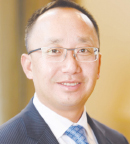Integrative Oncology is guest edited by Jun J. Mao, MD, MSCE, Laurance S. Rockefeller Chair in Integrative Medicine and Chief, Integrative Medicine Service, Memorial Sloan Kettering Cancer Center, New York.
GUEST EDITOR

Jun J. Mao, MD, MSCE
The ASCO Post’s Integrative Oncology series is intended to facilitate the availability of evidence-based information on integrative and complementary therapies sometimes used by patients with cancer. Shelly Latte-Naor, MD, and Guest Editor Jun J. Mao, MD, MSCE, explore the role patients’ expectations regarding alternative therapies plays during their cancer treatment as well as the importance of patient-centered communication to avoid interruptions in conventional cancer care.
An increasing number of patients with cancer pursue complementary and alternative medicine for symptom control and improvement in quality of life, but some also believe that complementary and alternative medicine can cure cancer. It is crucial for health-care providers to initiate communication about the use of complementary and alternative medicine, understand and manage patients’ expectations, and provide reliable sources of information. Patient-centered communication is essential to avoid delays or interruptions in conventional cancer care as well as to maximize the benefits and minimize the harms of using complementary and alternative medicine during cancer treatment.
Prevalence of Alternative Therapies Among Patients With Cancer
Use of complementary and alternative medicine is highly prevalent among patients with cancer and cancer survivors. Surveys indicate that up to 87% of patients with a diagnosis or history of cancer utilize modalities such as acupuncture, mind-body medicine, massage, herbs and nutritional supplements, or other forms of complementary and alternative medicine.1-4 Of concern are the unrealistic expectations that patients associate with these modalities, including prolonged survival and cancer cure.5 Also troubling are findings indicating that few patients discuss the use of such alternative therapies with their physicians.6,7

To foster open provider-patient dialogue, it is important to understand the factors that influence a patient’s decision to pursue complementary and alternative medicine as well as a patient’s expectations regarding treatment efficacy.— Shelly Latte-Naor, MD
Tweet this quote
The decision to use complementary and alternative medicine is often made without the knowledge of health-care providers and is strongly influenced by a patient’s social network.8 Observational studies report that patients tend not to disclose their use of complementary and alternative medicine for a variety of reasons: for instance, they may perceive their health-care providers as uninformed or holding negative attitudes toward complementary and alternative medicine9 or they may interpret their providers’ discouragement of the use of such therapies as a conflict between their own belief system and conventional medical care.10
Such perceived conflicts are concerning, as they can significantly impair a patient’s initiation and adherence to life-saving treatment.11-14 In a multisite prospective cohort study of patients with breast cancer, those using dietary supplements or a higher number of complementary and alternative medicine modalities were less likely to initiate clinically indicated chemotherapy.15 Therefore, medical guidance regarding complementary and alternative medicine use is critical, as unsupervised use has been associated with increased mortality across several cancer types.16 To foster open provider-patient dialogue, it is important to understand the factors that influence a patient’s decision to pursue complementary and alternative medicine as well as a patient’s expectations regarding treatment efficacy.
Factors That Influence Patients’ Use of Alternative Therapies
For many patients with cancer, “social network” is the main source of complementary and alternative medicine–related information and impacts the decision-making process regarding the use of alternative therapies.17-20 Furthermore, surveys of the general population and patients with breast cancer found that the influence of social network exceeded that of the Internet, books, or health-care providers.19,21 In addition, a descriptive study found that patients with breast cancer experiencing fatigue and side effects due to conventional cancer treatments may be prompted to rely on their social network and family for advice about alternative therapies, neglecting information they’ve read elsewhere.17
Helping Patients Set Realistic Expectations About Alternative Therapies
- Foster nonjudgmental discussions to encourage disclosure of use of complementary and alternative medicine
- Inquire about the sources of information the patient relies on when making decisions about alternative therapies
- Openly assess the expectations of using complementary and alternative medicine
- When unrealistic expectations are identified, provide reliable resources regarding the use of alternative therapies and encourage continued dialogue. When possible, refer patients to an integrative medicine specialist.
Endorsement by family and friends is also considered a major predictive factor of the use of complementary and alternative medicine.17,18,22 Often based on anecdotal information or on traditions, such endorsement may shape a patient’s expectations of the benefits. These expectations can range from wellness and relaxation to the hope for a cure for their cancer.22,23 In a cross-sectional study of more than 900 patients with cancer, we found that patients’ expectations included reductions in pain and stress; improvements in immune function or overall health; and, alarmingly, heightened expectations of increased longevity (24% vs 61% with family endorsement) and cancer cure (12% vs 37% with family endorsement).7
Dangers of Unrealistic Expectations
Whereas an expected benefit is a major behavioral determinant of the use of complementary and alternative medicine,22 unrealistic expectations can lead to rejection or delay of conventional care or to adverse effects due to unsupervised use.2,11,14 Descriptive studies have shown that patients who harbor unrealistic expectations risked abandoning, delaying, or interrupting conventional cancer treatment in favor of using alternative therapies, possibly affecting their prognosis and outcomes.8,10,12,21
Improving Communication With Patients About Alternative Therapies
To identify patients at risk of rejecting conventional treatment, it is important to foster patient-centered counseling and education about complementary and alternative medicine. When having such discussions, it is advisable to include family members, as providers often ask patients about their use of alternative therapies but neglect to ask about specific expectations and sources of information.
When possible, it is wise to involve an integrative medicine specialist with knowledge of safe use of complementary and alternative medicine in the cancer setting; this specialist may help foster trust by addressing patients’ health beliefs. Integrative oncology–trained providers can also facilitate setting realistic expectations by competently discussing complementary and alternative medicine modalities and contrasting available evidence with expectations, thereby improving positive experiences for patients and, ultimately, health outcomes.
Closing Thoughts
Increased awareness about the ubiquitous use of complementary and alternative medicine and the complex motivations associated with it is called for in the pursuit of patient-centered care. Encouraging disclosure and understanding patient expectations of complementary and alternative medicine have important implications for effective communication about alternative therapies. Not only can they foster shared decision-making, but they can also help identify patients at risk of rejecting life-saving treatment.
In discussing the use of alternative therapies with patients, it is important to:
- Foster nonjudgmental discussions to encourage disclosure of use of complementary and alternative medicine
- Inquire about the sources of information the patient relies on when making decisions about alternative therapies
- Openly assess the expectations of using complementary and alternative medicine
- When unrealistic expectations are identified, provide reliable resources regarding the use of alternative therapies and encourage continued dialogue. When possible, refer patients to an integrative medicine specialist. ■
Dr. Latte-Naor is Director, Mind-Body Medicine, and Assistant Attending Physician, Integrative Medicine Service, Memorial Sloan Kettering Cancer Center, New York. Ms. Gubili is Editor, Integrative Medicine Service, Memorial Sloan Kettering Cancer Center, New York.
DISCLOSURE: Drs. Latte-Naor and Mao reported no conflicts of interest.
REFERENCES
1. Zachariae R: Complementary and alternative medicine use among patients with cancer: A challenge in the oncologist-patient relationship. JAMA Oncol 2:1177-1178, 2016.
2. Cassileth BR, Vickers AJ: High prevalence of complementary and alternative medicine use among cancer patients: Implications for research and clinical care. J Clin Oncol 23:2590-2592, 2005.
3. Horneber M, Bueschel G, Dennert G, et al: How many cancer patients use complementary and alternative medicine: A systematic review and metaanalysis. Integr Cancer Ther 11:187-203, 2012.
4. Velicer CM, Ulrich CM: Vitamin and mineral supplement use among US adults after cancer diagnosis: A systematic review. J Clin Oncol 26:665-673, 2018.
5. National survey reveals surprising number of Americans believe alternative therapies can cure cancer. ASCO. October 30, 2018. Available at www.asco.org/about-asco/press-center/news-releases/national-survey-reveals-surprising-number-americans-believe. Accessed November 20, 2018.
6. Mao JJ, Palmer CS, Healy KE, et al: Complementary and alternative medicine use among cancer survivors: A population-based study. J Cancer Surviv 5:8-17, 2011.
7. Latte-Naor S, Sidlow R, Sun L, et al: Influence of family on expected benefits of complementary and alternative medicine in cancer patients. Support Care Cancer 26:2063-2069, 2018.
8. Tasaki K, Maskarinec G, Shumay DM, et al: Communication between physicians and cancer patients about complementary and alternative medicine: Exploring patients’ perspectives. Psychooncology 11:212-220, 2002.
9. Citrin DL, Bloom DL, Grutsch JF, et al: Beliefs and perceptions of women with newly diagnosed breast cancer who refused conventional treatment in favor of alternative therapies. Oncologist 17:607-612, 2012.
10. Shumay DM, Maskarinec G, Kakai H, et al: Why some cancer patients choose complementary and alternative medicine instead of conventional treatment. J Fam Pract 50:1067, 2001.
11. Singh H, Maskarinec G, Shumay DM: Understanding the motivation for conventional and complementary/alternative medicine use among men with prostate cancer. Integr Cancer Ther 4:187-194, 2005.
12. Chang EY, Glissmeyer M, Tonnes S, et al: Outcomes of breast cancer in patients who use alternative therapies as primary treatment. Am J Surg 192:471-473, 2006.
13. Balneaves LG, Truant TL, Kelly M, et al: Bridging the gap: Decision-making processes of women with breast cancer using complementary and alternative medicine. Support Care Cancer 15:973-983, 2007.
14. Hall JD, Bissonette EA, Boyd JC, et al: Motivations and influences on the use of complementary medicine in patients with localized prostate cancer treated with curative intent: Results of a pilot study. BJU Int 91:603-607, 2003.
15. Greenlee H, Neugut AI, Falci L, et al: Association between complementary and alternative medicine use and breast cancer chemotherapy initiation: The Breast Cancer Quality of Care Study. JAMA Oncol 2:1170-1176, 2016.
16. Johnson SB, Park HS, Gross CP, et al: Use of alternative medicine for cancer and its impact on survival. J Natl Cancer Inst 110:121-124, 2018.
17. Boon H, Brown JB, Gavin A, et al: Breast cancer survivors’ perceptions of complementary/alternative medicine: Making the decision to use or not to use. Qual Health Res 9:639-653, 1999.
18. Furlow ML, Patel DA, Sen A, et al: Physician and patient attitudes towards complementary and alternative medicine in obstetrics and gynecology. BMC Complement Altern Med 8:35, 2008.
19. Naja F, Fadel RA, Alameddine M, et al: Complementary and alternative medicine use and its association with quality of life among Lebanese breast cancer patients: A cross-sectional study. BMC Complement Altern Med 15:444, 2015.
20. Bauml JM, Chokshi S, Schapira MM, et al: Do attitudes and beliefs regarding complementary and alternative medicine impact its use among patients with cancer? A cross-sectional survey. Cancer 121:2431-2438, 2015.
21. Bishop FL, Yardley L, Lewith GT: Treat or treatment: A qualitative study analyzing patients’ use of complementary and alternative medicine. Am J Public Health 98:1700-1705, 2008.
22. Wanchai A, Armer JM, Stewart BR: Complementary and alternative medicine use among women with breast cancer: A systematic review. Clin J Oncol Nurs 14:E45-E55, 2010.
23. Verhoef MJ, White MA: Factors in making the decision to forgo conventional cancer treatment. Cancer Pract 10:201-207, 2002.

